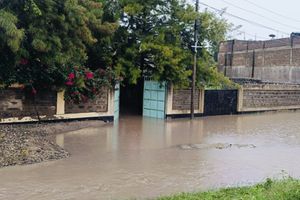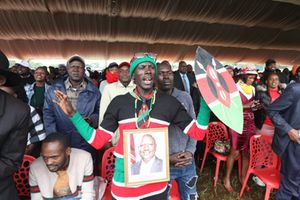Happening Now: Labour Day celebrations at Uhuru Gardens
Will choice of Karua as Raila’s deputy turn into actual votes?

The nomination of Ms Martha Karua as Mr Raila Odinga’s presidential election running mate has generated considerable buzz, much more so than the lukewarm reception seen on Deputy President William Ruto’s unveiling of Mr Rigathi Gachagua.
However, it remains to be seen if excitement around the Narc Kenya leader will translate into actual votes for Mr Odinga’s fifth presidential bid on two critical parameters: the women’s vote and the Mt Kenya basket.
With Deputy President Ruto’s Kenya Kwanza Alliance enjoying a healthy lead in the populous region, Ms Karua has the difficult task of winning over a generally hostile populace for the Azimio la Umoja One Kenya Coalition Party. This will make the presidential campaign in the region a direct contest between the two running mates.
Many are wont to dismiss the excitement generated by Ms Karua’s candidacy as just a high-class urban thing in the cocktail circuit and civil society circles with little resonance with a majority of voters.
They point to the fact that Ms Karua was in her own right a presidential candidate in 2013 and performed dismally, with no indication of the women’s vote working in her favour. They point also to other well-known women presidential candidates, such as Charity Ngilu and Wangari Maathai, both in 1997, who were hardly boosted by a gender that makes up roughly 50 per cent of the population, and even higher proportion of voters.
The abysmally poor representation of women in the National Assembly, Senate, County Assemblies and Governor’s mansions also indicates that the women’s lobby is inconsequential to Kenyan voting patterns.
Ms Karua’s 2013 presidential bid on her Narc Kenya ticket, with Mr Augustine Lotodo as her running mate, saw her end up near the bottom of the field—sixth in a field of eight—with a paltry 43,881, a mere 0.36 per cent of the total vote. This was dismal from a candidate who was already a national figure with a long unbroken stint as MP for Gichugu since 1992, an influential Cabinet minister in the government of President Mwai Kibaki, and a genuine hero in the struggle against one-party dictatorship. Ms Karua was behind even the quirky campaign of the previously unknown Abduba Dida who emerged fifth with 52,548 votes, 0.43 per cent of the total.
There was another female candidate in the 2013 race, Ms Winnie Kaburu, who was the running mate of Prof James Kiyiapi on the Restore and Build Kenya ticket. She got 40,998 votes, 0.34 per cent, one position below Ms Karua. That could be seen as impressive considering that they were hardly anywhere near the Narc Kenya candidate in terms of political experience and name recognition.
How far Ms Karua trailed can be measured by the fact that the winner, the Jubilee Alliance pair of Uhuru Kenyatta and William Ruto, garnered over 6.2 million votes, followed by Raila Odinga and Kalonzo Musyoka on the Cord coalition ticket with 5.3 million votes. Mr Musalia Mudavadi and Jeremiah Kioni trailed a distant third with under 484,000 votes.
Another woman presidential candidate who performed way below expectation was Prof Maathai, a global environmental activism icon, whose 1997 bid on the Labour Party ticket returned a measly 4,246 votes, 0.07 per cent of the total. She was 13th in a crowded field of 15 candidates.
In the same election however, then Kitui Central MP and present Kitui Governor Charity Ngilu had performed notably with 488,600 votes on the Social Democratic Party ticket. She was fifth in the field of 15, quite some way behind Kanu’s President Daniel arap Moi retaining his seat with 2.5 million votes followed by Mr Kibaki of the Democratic Party with just under 2 million votes.
Mrs Ngilu’s performance was impressive considering she wasn’t that far behind the other two notable candidates, Raila Odinga on NDP with about 668,000 votes and Kijana Wamalwa of Ford Kenya with just over a half million votes.
That performance remains a landmark for women presidential candidates in Kenya, but it’s difficult to tell how much of her vote reflected women’s turnout in her favour.
What was striking about her candidacy was the issue-driven campaign that sought to distinguish SDP as devoted to social justice, the party of basic needs, against the others, which were just business-as-usual mobilisation of ethnic blocs. Mrs Ngilu, however, scooped a healthy vote in her Lower Easter region. Her 7.89 per cent of the total national vote was not very far behind the 8.9 per cent Wiper Party leader and presumed Lower Eastern kingpin Kalonzo Musyoka scooped in his 2007 presidential bid.
The only other women presidential candidates in Kenyan history have been Ms Nazlin Omar, who ran on the Workers Congress ticket in 2007, winning 8,624 votes, 0.09 per cent of the total, to finish sixth in a field of nine.
In 2017, there was Ms Miriam Mutua, running mate for independent candidate Michael Wainaina, who tailed the field of eight with 8,870 votes, 0.06 per cent of the total.
From the above, there’s little evidence of women’s activism ever influencing presidential elections outcome in Kenya, save for Ngilu’s 1997 performance.
But it’s also apparent that all women who ran either as principals or running mate did so on alternative or fringe party tickets with absolutely no prospects of winning, leave alone performing well. The difference this time is that Ms Karua running with Mr Odinga presents very realistic prospects of victory.
Another strong factor in her favour is that Ms Karua as Deputy President would present the alluring prospect of the first woman President in Kenya once Mr Odinga serves out his term.
Although the Ruto camp is putting on a brave face and dismissing Ms Karua nomination as inconsequential, the reality is that it is rattled and planning aggressive counter-measures. It was not for nothing that when announcing the choice of Mr Gachagua, DP Ruto promised to reserve half of his cabinet slots for women.
He is also planning a series of campaign forays in the Mt Kenya region, closely trailing the footsteps of Ms Karua. His ‘Hustler Nation’ social media armies have also been mobilised to ramp up a propaganda blitz against Ms Karua. It seems the ‘Strength of a Woman’ can no longer be ignored.





